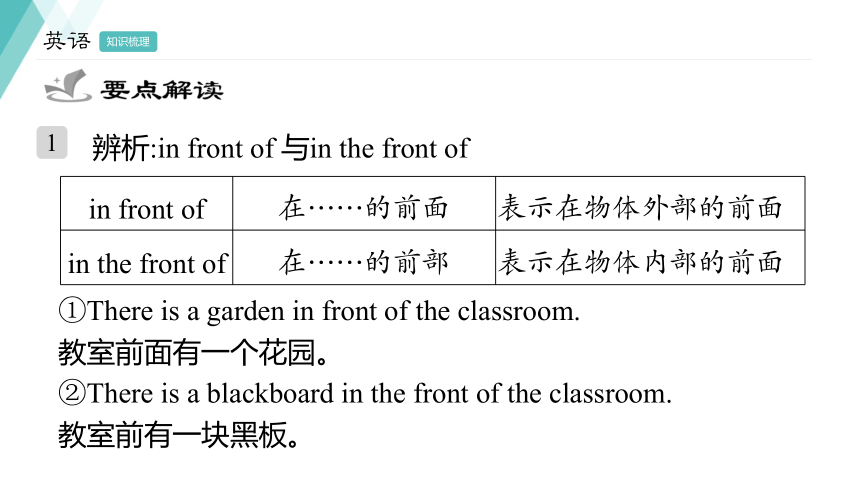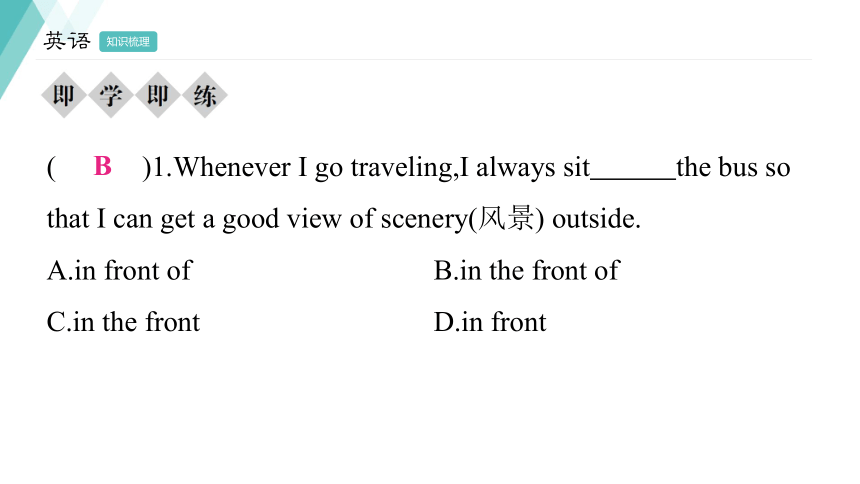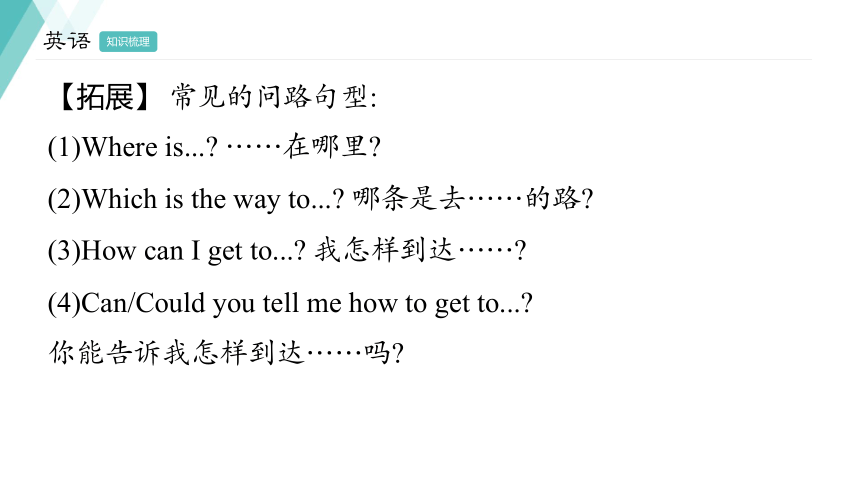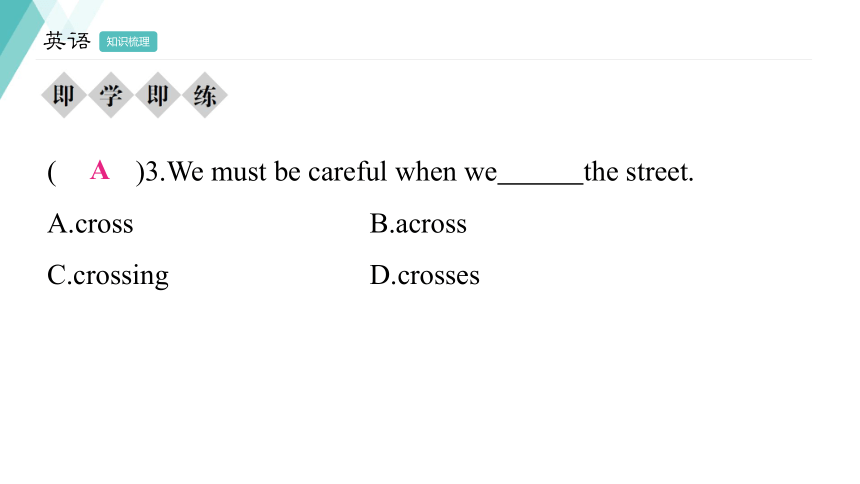Module 6 Unit 1 Could you tell me how to get to the National Stadium?复习课件(共25张PPT)
文档属性
| 名称 | Module 6 Unit 1 Could you tell me how to get to the National Stadium?复习课件(共25张PPT) |  | |
| 格式 | pptx | ||
| 文件大小 | 642.6KB | ||
| 资源类型 | 教案 | ||
| 版本资源 | 外研版 | ||
| 科目 | 英语 | ||
| 更新时间 | 2024-06-14 06:27:43 | ||
图片预览









文档简介
(共25张PPT)
Unit 1 Could you tell me how
to get to the National Stadium
外研社版 七年级英语下册
英语
知识梳理
1
辨析:in front of 与in the front of
in front of 在……的前面 表示在物体外部的前面
in the front of 在……的前部 表示在物体内部的前面
①There is a garden in front of the classroom.
教室前面有一个花园。
②There is a blackboard in the front of the classroom.
教室前有一块黑板。
英语
知识梳理
( )1.Whenever I go traveling,I always sit the bus so that I can get a good view of scenery(风景) outside.
A.in front of B.in the front of
C.in the front D.in front
B
英语
知识梳理
2
句型“Can you tell me the way to... ”的用法
(1)Can you tell me the way to... 是问路的常用句式,意为“你能告诉我去……的路吗 ”,can可用could代替,语气较委婉。
(2)the way to...意为“去……的路”,to是介词,后面接表示地点的名词(短语),若地点是副词,则省略to。
①Could you tell me the way to the post office
你能告诉我去邮局的路吗
②We all know the way there.我们都知道去那里的路。
英语
知识梳理
【拓展】 常见的问路句型:
(1)Where is... ……在哪里
(2)Which is the way to... 哪条是去……的路
(3)How can I get to... 我怎样到达……
(4)Can/Could you tell me how to get to...
你能告诉我怎样到达……吗
英语
知识梳理
2.用所给词的适当形式填空。
—Do you know the way (get)to the People’s Cinema
—Yes.Walk along the street,and you will see it on your right.
to get
英语
知识梳理
3
辨析:across与cross
across 介词 意为“越过”,着重指从一定范围的一边到另一边,强调从物体表面穿过,常与go,walk和run等动词连用
cross 及物 动词 意为“穿过,横过”,强调从物体表面上横过,其后常接road,street,bridge,river等名词,相当于go across。
英语
知识梳理
It’s very dangerous for children to cross the busy street.
=It’s very dangerous for children to go across the busy street.
对孩子们来说穿过车来车往的街道很危险。
英语
知识梳理
( )3.We must be careful when we the street.
A.cross B.across
C.crossing D.crosses
A
英语
知识梳理
( )4.Don’t use your mobile phone when you go the road.It’s dangerous.
A.down B.over
C.into D.across
D
英语
知识梳理
4
along的用法
along作介词,意为“沿着”,go along意为“沿着……走”,多指沿着街道、道路、河边或堤坝等往前走。
Go along the street and you’ll see an underground station.
沿着这条街走,你会看到一个地铁站。
【拓展】 along还可作副词,意为“向前;一起;一道”。
Let’s walk along. 咱们向前走走吧。
英语
知识梳理
( )5.My father has a habit of jogging(慢跑) the Jinchuan River for an hour in the morning.
A.between B.along
C.over D.through
B
英语
知识梳理
5
turn left/right的用法
turn left/right 意为“向左/右转”,是固定搭配,其中turn是动词,意为“换方向”。
Go straight and turn left at the next crossing.
直走,然后在下一个交叉道口左拐。
英语
知识梳理
【拓展】 关于turn常见的短语有:
turn left/right向左/右转 turn on 打开
turn off 关闭 turn into 变成
turn in 上交 turn up 开大;调高
turn down 关小;调低
英语
知识梳理
( )6.—Could you please the light It is too dark(黑暗的) here.
—OK,I’ll do it in a minute.
A.turn right B.turn left
C.turn off D.turn on
D
英语
知识梳理
6
opposite的用法
opposite作介词,意为“在……的对面”,相当于across from。常与名词一起构成介词,表示方位。
The fruit shop is opposite/across from the hospital.
水果店在医院的对面。
【拓展】 opposite作形容词,意为“对面的;相反的”。常见搭配:be opposite to意为“与……相反;在……对面”。
My house is opposite to hers.我的房子在她家的对面。
英语
知识梳理
7.在我的家乡,学校对面有一棵很大的古树。
In my hometown,there is a big old tree the school.
opposite
英语
知识梳理
7
句型Why not... 的用法
Why not do... 意为“为什么不做……呢 ”,是一个提出建议或征求意见的句型,相当于“Why don’t you do... ”。
Why not read newspapers in English
=Why don’t you read newspapers in English
你为什么不读英文报纸呢
英语
知识梳理
【拓展】 “Why not ”可以单独使用,表示同意或赞成,意为“好的。/可以呀。/为什么不呢 ”。
—May I go with you 我可以和你一起去吗
—Why not 可以呀。
英语
知识梳理
( )8.—It’s too hot.Why not swimming
— It’s a good idea.Let’s go.
A.go B.goes
C.going D.to go
A
英语
知识梳理
8
“take+交通工具”的用法
“take a/the+交通工具”意为“乘(坐)……”,“take the...to...”相当于“go...by+交通工具”。
I usually take the bus to school.=I usually go to school by bus.
我通常乘公共汽车去上学。
英语
知识梳理
【归纳】 出行方式的常用表达
take+冠词+交通工具名词 交通工具名词前必须有冠词
take a/the car/bus/train/ship/taxi/plane
乘汽车/公共汽车/火车/轮船/出租车/飞机
by+交通工具名词 在句子作方式状语。注意:“步行”要用“on foot”
by bike/bus/train/plane(air)/ship(sea)/underground
骑自行车/乘公共汽车/火车/飞机/船/地铁
英语
知识梳理
用某些动词+to 其后常接地点名词或地点副词,接地点副词时省略to
walk to步行去;drive to开车去;fly to乘飞机去;ride to骑马/自行车去
英语
知识梳理
9.为了省钱,她总是坐公共汽车去上班。
She always to work to save money.
( )10.—You can take subway to the museum.
—No,I will go there by bike.
A./;the B.the;/
C.the;the D.a;a
takes
a
bus
B
谢谢观看
外研社版 七年级英语下册
This is the last of the postings.
Thank you for watching.
知识梳理
Unit 1 Could you tell me how
to get to the National Stadium
外研社版 七年级英语下册
英语
知识梳理
1
辨析:in front of 与in the front of
in front of 在……的前面 表示在物体外部的前面
in the front of 在……的前部 表示在物体内部的前面
①There is a garden in front of the classroom.
教室前面有一个花园。
②There is a blackboard in the front of the classroom.
教室前有一块黑板。
英语
知识梳理
( )1.Whenever I go traveling,I always sit the bus so that I can get a good view of scenery(风景) outside.
A.in front of B.in the front of
C.in the front D.in front
B
英语
知识梳理
2
句型“Can you tell me the way to... ”的用法
(1)Can you tell me the way to... 是问路的常用句式,意为“你能告诉我去……的路吗 ”,can可用could代替,语气较委婉。
(2)the way to...意为“去……的路”,to是介词,后面接表示地点的名词(短语),若地点是副词,则省略to。
①Could you tell me the way to the post office
你能告诉我去邮局的路吗
②We all know the way there.我们都知道去那里的路。
英语
知识梳理
【拓展】 常见的问路句型:
(1)Where is... ……在哪里
(2)Which is the way to... 哪条是去……的路
(3)How can I get to... 我怎样到达……
(4)Can/Could you tell me how to get to...
你能告诉我怎样到达……吗
英语
知识梳理
2.用所给词的适当形式填空。
—Do you know the way (get)to the People’s Cinema
—Yes.Walk along the street,and you will see it on your right.
to get
英语
知识梳理
3
辨析:across与cross
across 介词 意为“越过”,着重指从一定范围的一边到另一边,强调从物体表面穿过,常与go,walk和run等动词连用
cross 及物 动词 意为“穿过,横过”,强调从物体表面上横过,其后常接road,street,bridge,river等名词,相当于go across。
英语
知识梳理
It’s very dangerous for children to cross the busy street.
=It’s very dangerous for children to go across the busy street.
对孩子们来说穿过车来车往的街道很危险。
英语
知识梳理
( )3.We must be careful when we the street.
A.cross B.across
C.crossing D.crosses
A
英语
知识梳理
( )4.Don’t use your mobile phone when you go the road.It’s dangerous.
A.down B.over
C.into D.across
D
英语
知识梳理
4
along的用法
along作介词,意为“沿着”,go along意为“沿着……走”,多指沿着街道、道路、河边或堤坝等往前走。
Go along the street and you’ll see an underground station.
沿着这条街走,你会看到一个地铁站。
【拓展】 along还可作副词,意为“向前;一起;一道”。
Let’s walk along. 咱们向前走走吧。
英语
知识梳理
( )5.My father has a habit of jogging(慢跑) the Jinchuan River for an hour in the morning.
A.between B.along
C.over D.through
B
英语
知识梳理
5
turn left/right的用法
turn left/right 意为“向左/右转”,是固定搭配,其中turn是动词,意为“换方向”。
Go straight and turn left at the next crossing.
直走,然后在下一个交叉道口左拐。
英语
知识梳理
【拓展】 关于turn常见的短语有:
turn left/right向左/右转 turn on 打开
turn off 关闭 turn into 变成
turn in 上交 turn up 开大;调高
turn down 关小;调低
英语
知识梳理
( )6.—Could you please the light It is too dark(黑暗的) here.
—OK,I’ll do it in a minute.
A.turn right B.turn left
C.turn off D.turn on
D
英语
知识梳理
6
opposite的用法
opposite作介词,意为“在……的对面”,相当于across from。常与名词一起构成介词,表示方位。
The fruit shop is opposite/across from the hospital.
水果店在医院的对面。
【拓展】 opposite作形容词,意为“对面的;相反的”。常见搭配:be opposite to意为“与……相反;在……对面”。
My house is opposite to hers.我的房子在她家的对面。
英语
知识梳理
7.在我的家乡,学校对面有一棵很大的古树。
In my hometown,there is a big old tree the school.
opposite
英语
知识梳理
7
句型Why not... 的用法
Why not do... 意为“为什么不做……呢 ”,是一个提出建议或征求意见的句型,相当于“Why don’t you do... ”。
Why not read newspapers in English
=Why don’t you read newspapers in English
你为什么不读英文报纸呢
英语
知识梳理
【拓展】 “Why not ”可以单独使用,表示同意或赞成,意为“好的。/可以呀。/为什么不呢 ”。
—May I go with you 我可以和你一起去吗
—Why not 可以呀。
英语
知识梳理
( )8.—It’s too hot.Why not swimming
— It’s a good idea.Let’s go.
A.go B.goes
C.going D.to go
A
英语
知识梳理
8
“take+交通工具”的用法
“take a/the+交通工具”意为“乘(坐)……”,“take the...to...”相当于“go...by+交通工具”。
I usually take the bus to school.=I usually go to school by bus.
我通常乘公共汽车去上学。
英语
知识梳理
【归纳】 出行方式的常用表达
take+冠词+交通工具名词 交通工具名词前必须有冠词
take a/the car/bus/train/ship/taxi/plane
乘汽车/公共汽车/火车/轮船/出租车/飞机
by+交通工具名词 在句子作方式状语。注意:“步行”要用“on foot”
by bike/bus/train/plane(air)/ship(sea)/underground
骑自行车/乘公共汽车/火车/飞机/船/地铁
英语
知识梳理
用某些动词+to 其后常接地点名词或地点副词,接地点副词时省略to
walk to步行去;drive to开车去;fly to乘飞机去;ride to骑马/自行车去
英语
知识梳理
9.为了省钱,她总是坐公共汽车去上班。
She always to work to save money.
( )10.—You can take subway to the museum.
—No,I will go there by bike.
A./;the B.the;/
C.the;the D.a;a
takes
a
bus
B
谢谢观看
外研社版 七年级英语下册
This is the last of the postings.
Thank you for watching.
知识梳理
同课章节目录
- Module 1 Lost and found
- Unit 1 Whose bag is this?
- Unit 2 Are they yours?
- Unit 3 Language in use
- Module 2 What can you do ?
- Unit 1 I can play the piano
- Unit 2 I can run really fast
- Unit 3 Language in use
- Module 3 Making plans
- Unit 1 What are you going to do at the weekends?
- Unit 2 We're going to cheer the players.
- Unit 3 Language in use
- Module 4 Life in the future
- Unit 1 Everyone will study at home
- Unit 2 Every family will have a small plane.
- Unit 3 Language in use
- Module 5 Shopping
- Unit 1 What can I do for you?
- Unit 2 You can buy everything on the Internet
- Unit 3 Language in use
- Module 6 Around town
- Unit 1 Could you tell me how to get to the Nationa
- Unit 2 The London Eye is on your right.
- Unit 3 Language in use
- Revision module A
- Module 7 My past life
- Unit 1 I was born in a small village.
- Unit 2 I was born in Quincy.
- Unit 3 Language in use
- Module 8 Story time
- Unit 1 Once upon a time….
- Unit 2 Goldilocks hurried out of the house.
- Unit 3 Language in use
- Module 9 Life history
- Unit 1 He left school and began work at the age of
- Unit 2 He decided to be an actor.
- Unit 3 Language in use
- Module 10 A holiday journey
- Unit 1 What did you do?
- Unit 2 This morning we took a walk.
- Unit 3 Language in use
- Module 11 Body language
- Unit 1 They touch noses!
- Unit 2 Here are some ways to welcome them.
- Unit 3 Language in use
- Module 12 Western music
- Unit 1 It's so beautiful!
- Unit 2 Vienna is the centre of European classical
- Unit 3 Language in use
- Revision module B
